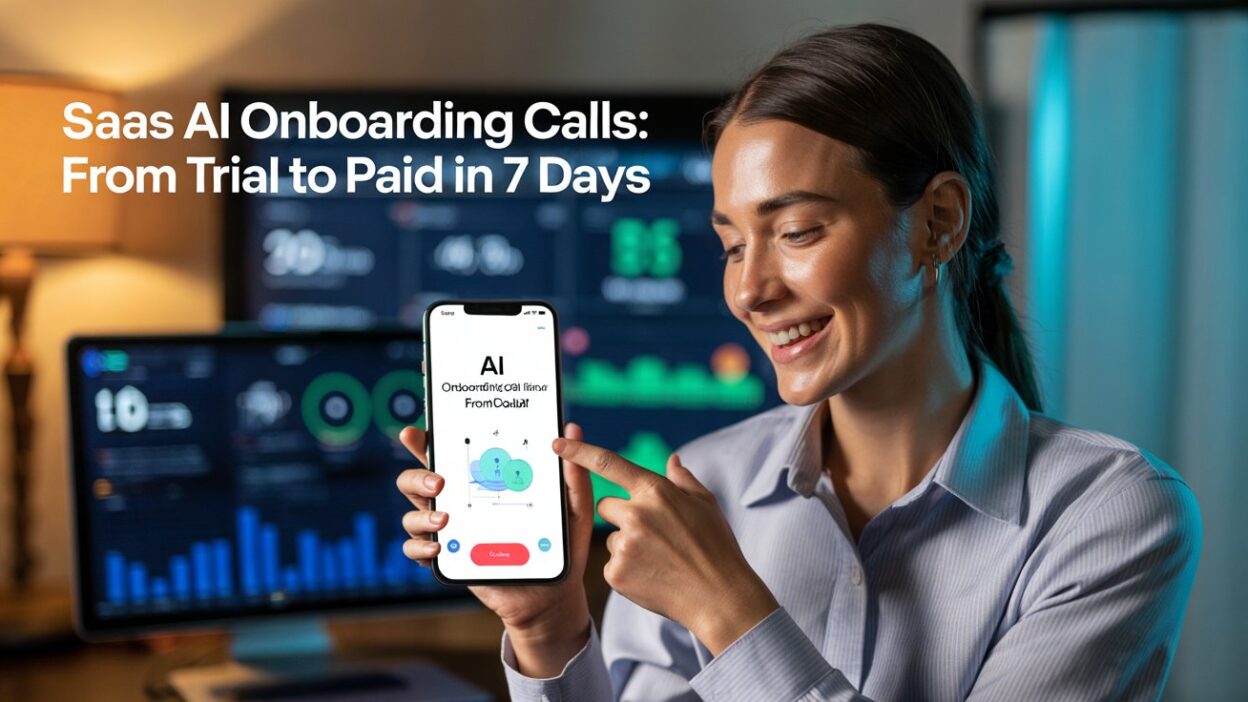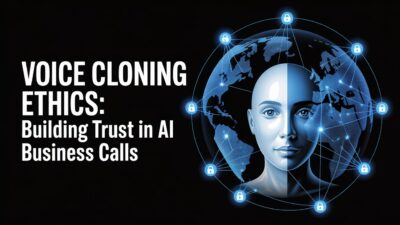In the competitive landscape of Software as a Service (SaaS), the difference between thriving and merely surviving often comes down to how effectively you can convert trial users into paying customers. While many SaaS companies focus heavily on acquisition metrics, the real magic happens during those critical first seven days when new users are deciding whether your product delivers on its promises. This is where SaaS AI customer onboarding calls become a game-changing strategy that can dramatically improve conversion rates and accelerate revenue growth.
Table of Contents
Traditional onboarding processes rely heavily on self-service tutorials, email sequences, and static documentation. While these resources have their place, they often fail to address the unique challenges and questions that each user faces. SaaS AI customer onboarding calls bridge this gap by providing personalized, intelligent guidance that adapts to each user’s specific needs, industry, and technical proficiency level.
The seven-day window represents the sweet spot for conversion optimization. Research consistently shows that users who don’t experience meaningful value within their first week are unlikely to convert to paid plans. By leveraging AI-powered onboarding calls during this crucial period, SaaS companies can identify at-risk users, provide targeted assistance, and guide prospects toward their “aha moment” faster than ever before.
The Evolution of SaaS Customer Onboarding
The traditional approach to SaaS onboarding has evolved significantly over the past decade. Early SaaS companies relied primarily on email-based tutorials and basic documentation, expecting users to figure out complex software independently. As competition intensified, companies began investing in more sophisticated onboarding experiences, including interactive product tours, video tutorials, and progressive disclosure of features.
However, these improvements still left a significant gap in personalization and real-time problem-solving. Users with different backgrounds, industries, and technical skill levels often struggled with one-size-fits-all onboarding approaches. High-value prospects might abandon promising trials simply because they couldn’t quickly identify how the software would solve their specific challenges.
SaaS AI customer onboarding calls represent the next evolution in this space, combining the scalability of automated systems with the personalization and problem-solving capabilities traditionally associated with human sales and success teams. These intelligent systems can engage with hundreds of trial users simultaneously, providing customized guidance that addresses individual needs while identifying the most promising conversion opportunities for human follow-up.
How SaaS AI Customer Onboarding Calls Transform Trial Conversion
The implementation of AI-powered onboarding calls fundamentally changes the trial-to-paid conversion dynamic. Instead of passively waiting for users to navigate the onboarding process independently, businesses can proactively engage with prospects at optimal moments, providing guidance, answering questions, and removing friction from the conversion path.
Modern SaaS AI customer onboarding calls utilize sophisticated natural language processing to understand user responses, identify pain points, and provide relevant solutions in real-time. These systems can detect frustration in a user’s voice, recognize when someone is struggling with a particular feature, and automatically adjust their approach to provide more detailed explanations or alternative solutions.
The AI systems continuously learn from each interaction, becoming more effective at identifying conversion signals and optimizing their communication strategies. This means that over time, SaaS AI customer onboarding calls become increasingly sophisticated at recognizing which users are most likely to convert and what specific interventions are most effective for different user segments.
The Science Behind 7-Day Conversion Windows
The seven-day timeframe isn’t arbitrary; it’s based on extensive research into user behavior patterns and decision-making psychology. Studies across multiple SaaS verticals consistently show that trial users who don’t achieve a meaningful outcome within their first week have conversion rates below 5%, while those who experience early success convert at rates exceeding 40%.
This pattern exists because of several psychological and practical factors. First, the initial enthusiasm that drove someone to start a trial begins to wane after about a week if they haven’t seen clear value. Second, competing priorities and daily responsibilities start to crowd out time for exploring new software unless users have already identified compelling benefits.
SaaS AI customer onboarding calls capitalize on this timeline by ensuring that users receive appropriate guidance and support during their most receptive period. By proactively addressing common obstacles and highlighting relevant features within the first seven days, these systems can significantly improve the likelihood that users will reach their activation milestones and convert to paid plans.
Strategic Implementation of AI-Powered Onboarding Calls
Timing and Trigger Optimization
Successful implementation of SaaS AI customer onboarding calls requires careful consideration of timing and triggers. The most effective systems don’t simply call every trial user at predetermined intervals; instead, they use behavioral data and predictive analytics to identify optimal engagement moments.
For example, users who sign up but don’t complete initial setup steps within 24 hours might receive a proactive call offering setup assistance. Similarly, users who explore multiple features but haven’t created their first project or achieved a key milestone might be contacted with guidance on how to accomplish specific goals relevant to their industry or use case.
The AI systems can also detect signs of user frustration or confusion, such as repeated attempts to access help documentation or multiple failed attempts to complete specific actions. These behavioral signals trigger immediate outreach designed to provide assistance before users become too frustrated to continue with their trial.
Personalization and Context Awareness
One of the key advantages of SaaS AI customer onboarding calls is their ability to provide highly personalized experiences at scale. These systems can access user profile information, trial activity data, and industry-specific knowledge to tailor each conversation to the individual user’s context and needs.
A marketing manager at a startup will receive different guidance than a enterprise IT director, even if they’re both evaluating the same software. The AI system understands these contextual differences and adjusts its communication style, feature recommendations, and success metrics accordingly.
This personalization extends to understanding technical proficiency levels as well. Users who demonstrate advanced technical knowledge through their trial activity receive more sophisticated explanations and advanced feature recommendations, while less technical users receive simplified guidance focused on achieving business outcomes without getting lost in technical details.
Industry-Specific Applications and Success Patterns
B2B Software Platforms
Business-to-business SaaS platforms have seen particularly impressive results from implementing AI-powered onboarding calls. These complex software solutions often require significant time investment to understand and configure properly, making personalized guidance especially valuable. SaaS AI customer onboarding calls can walk users through industry-specific setup processes, demonstrate relevant integrations, and highlight features that address common business challenges in their sector.
Companies offering project management, customer relationship management, and business intelligence solutions have reported conversion rate improvements of 25-60% after implementing AI-powered onboarding calls during the trial period. The ability to provide immediate answers to complex configuration questions and demonstrate specific use cases relevant to each prospect’s industry has proven particularly effective.
Technical and Developer Tools
Developer-focused SaaS products face unique onboarding challenges, as their users often have high technical expectations but limited time to evaluate new tools. SaaS AI customer onboarding calls for technical products can provide code examples, troubleshoot integration issues, and demonstrate advanced features that might not be immediately obvious to new users.
These AI systems can detect when developers are struggling with API documentation or having difficulty implementing specific features, triggering proactive assistance that helps them achieve their technical goals more quickly. This targeted support during the trial period significantly improves conversion rates for complex technical products.
Marketing and Sales Automation
Marketing and sales automation platforms benefit tremendously from AI-powered onboarding calls because these tools often require significant setup and configuration to demonstrate their full value. The AI systems can guide users through campaign creation, lead scoring setup, and integration with existing marketing stacks, ensuring that trial users experience the full power of the platform within their evaluation period.
Advanced Features and Capabilities
Modern SaaS AI customer onboarding calls incorporate sophisticated technologies that go far beyond simple scripted conversations. Natural language processing enables these systems to understand complex questions and provide detailed, contextually appropriate responses. Machine learning algorithms continuously improve conversation quality by analyzing successful interactions and identifying patterns that lead to higher conversion rates.
Voice analytics capabilities allow the AI systems to detect emotional cues in user responses, adjusting their approach when users seem frustrated or confused. Sentiment analysis helps identify when users are excited about specific features, enabling the AI to provide additional information about related capabilities that might further increase engagement.
Integration with existing customer data platforms ensures that SaaS AI customer onboarding calls have access to comprehensive user profiles, enabling highly personalized conversations that reference specific user characteristics, previous interactions, and stated goals from the signup process.
Measuring Success and Optimizing Performance
Key Performance Indicators
Successful implementation of SaaS AI customer onboarding calls requires careful tracking of relevant metrics and continuous optimization based on performance data. Primary conversion metrics include trial-to-paid conversion rates, time-to-activation, and revenue per trial user. These core metrics provide insight into the overall effectiveness of the AI-powered onboarding process.
Secondary metrics such as feature adoption rates, user engagement scores, and support ticket volume during the trial period provide additional insight into how well the AI system is addressing user needs and removing friction from the onboarding experience. Tracking these metrics across different user segments helps identify opportunities for further personalization and optimization.
Continuous Improvement Through Machine Learning
One of the most powerful aspects of SaaS AI customer onboarding calls is their ability to continuously improve through machine learning algorithms. Each conversation provides data that helps the system better understand which approaches are most effective for different types of users and situations.
The AI systems can identify patterns in successful conversions, such as specific features that generate the most excitement or particular explanation approaches that lead to higher engagement. This learning capability means that the effectiveness of SaaS AI customer onboarding calls improves over time, providing increasingly better results as the systems process more interactions.
Integration with Existing Sales and Marketing Systems
Effective implementation of SaaS AI customer onboarding calls requires seamless integration with existing sales and marketing technology stacks. The AI systems should connect with customer relationship management platforms, marketing automation tools, and product analytics systems to provide a comprehensive view of each user’s journey.
This integration enables the AI to access historical interaction data, understand previous touchpoints with the brand, and coordinate with human sales and success teams when appropriate. Users who express high interest or have specific complex requirements can be seamlessly transferred to human representatives who have full context about the AI conversation and user needs.
The integration also enables sophisticated lead scoring and prioritization, allowing sales teams to focus their attention on the most promising prospects while the AI system handles routine onboarding support for the broader trial user base.
Overcoming Common Implementation Challenges
Technical Integration Complexity
Implementing SaaS AI customer onboarding calls often requires significant technical integration work, particularly for companies with complex existing technology stacks. Successful implementations require careful planning around data synchronization, API integrations, and user privacy compliance.
Companies should budget adequate time and resources for technical integration, working closely with their AI provider to ensure seamless data flow and consistent user experiences across all touchpoints. Testing and quality assurance become particularly important when integrating AI systems with existing customer data and communication platforms.
Maintaining Brand Consistency
Ensuring that AI-powered conversations maintain appropriate brand voice and messaging consistency presents another common challenge. The AI systems must be trained on brand-specific language, tone, and positioning to ensure that every interaction reinforces the company’s overall marketing message and brand personality.
Regular quality assurance reviews and conversation monitoring help identify when AI responses drift from brand guidelines, enabling quick corrections and continuous improvement in brand alignment. Companies should establish clear guidelines for AI conversation tone and style, providing comprehensive training data that reflects their desired brand personality.
Future Trends and Technological Advancements
The future of SaaS AI customer onboarding calls looks increasingly sophisticated, with emerging technologies promising even more advanced personalization and effectiveness. Integration with predictive analytics will enable AI systems to anticipate user needs and proactively provide assistance before users even realize they need help.
Advanced emotional intelligence capabilities will allow future systems to better understand user frustration, excitement, and confusion, adapting their communication style in real-time to provide more effective support. Voice synthesis improvements will create more natural-sounding interactions that feel less artificial and more engaging.
Integration with augmented reality and screen-sharing technologies could enable AI systems to provide visual guidance alongside voice support, walking users through complex software interfaces with real-time visual assistance.
Building a Comprehensive Onboarding Strategy
SaaS AI customer onboarding calls work best as part of a comprehensive onboarding strategy that includes multiple touchpoints and support mechanisms. While AI-powered calls provide personalized guidance and problem-solving capabilities, they should complement rather than replace other onboarding elements such as product tutorials, documentation, and human support options.
The most successful implementations create seamless handoffs between AI and human representatives, ensuring that users receive appropriate levels of support based on their specific needs and the complexity of their requirements. High-value prospects or users with complex technical questions should have easy access to human experts when needed.
Read More: Maximize Efficiency Using Intelligent Call Routing Software
Conclusion

SaaS AI customer onboarding calls represent a fundamental evolution in how software companies approach trial conversion and customer success. By providing personalized, intelligent guidance during the critical first seven days of the trial experience, these systems can dramatically improve conversion rates while reducing the operational burden on human sales and success teams.
The technology has matured to the point where AI-powered onboarding calls can handle complex questions, provide detailed product guidance, and identify conversion opportunities with remarkable accuracy. As competition in the SaaS market continues to intensify, companies that leverage these advanced onboarding capabilities will have significant advantages in converting prospects into satisfied, long-term customers.
The seven-day conversion window represents a crucial opportunity that many SaaS companies are still not fully optimizing. By implementing SaaS AI customer onboarding calls during this critical period, businesses can ensure that more trial users reach their activation milestones, experience meaningful value from the software, and convert to paid plans at higher rates than ever before.
For SaaS companies ready to transform their trial conversion performance, the implementation of AI-powered onboarding calls offers a clear path to improved revenue growth and customer success. The question is not whether to adopt this technology, but how quickly companies can implement these systems to gain competitive advantage in an increasingly crowded marketplace.






[…] Also Read: SaaS AI Onboarding Calls: From Trial To Paid In 7 Days […]